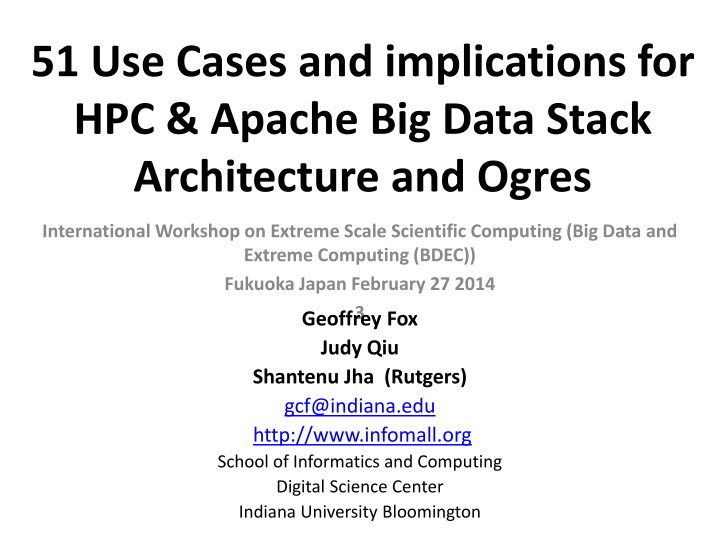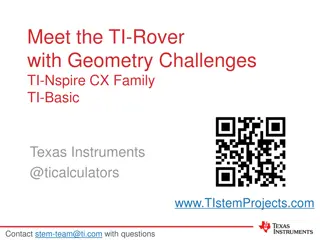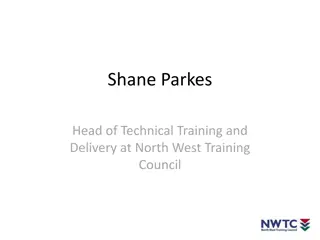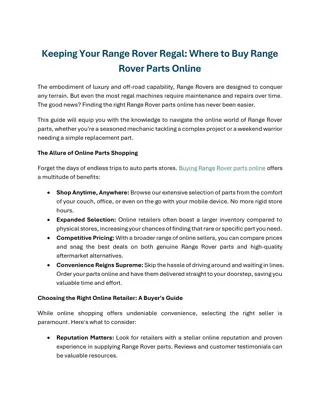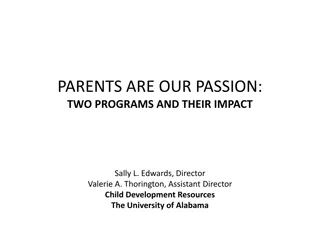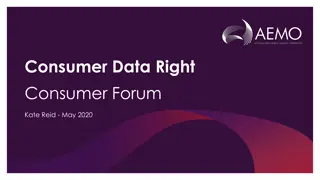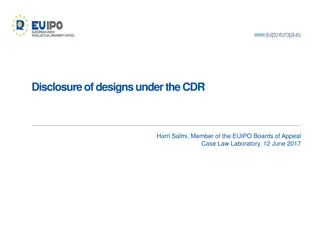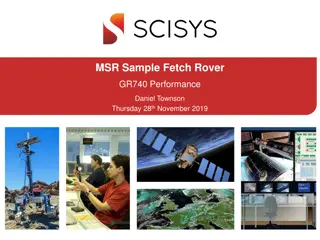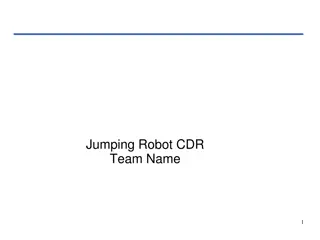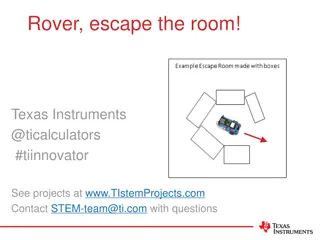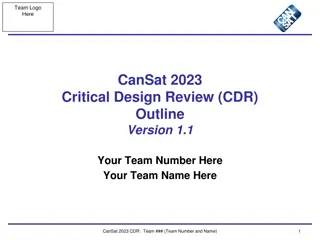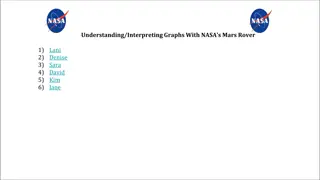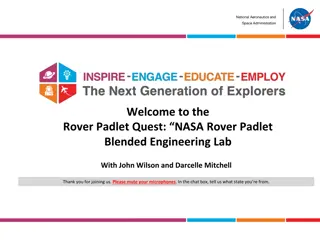Rover CDR Team Presentation Structure
This presentation outlines the team organization, mission summary, system requirements, design concepts, and operation overview for a rover and rocket. It includes details on changes since PDR and individual design focuses. The visuals aid in understanding the complex information within the presentation."
Download Presentation

Please find below an Image/Link to download the presentation.
The content on the website is provided AS IS for your information and personal use only. It may not be sold, licensed, or shared on other websites without obtaining consent from the author.If you encounter any issues during the download, it is possible that the publisher has removed the file from their server.
You are allowed to download the files provided on this website for personal or commercial use, subject to the condition that they are used lawfully. All files are the property of their respective owners.
The content on the website is provided AS IS for your information and personal use only. It may not be sold, licensed, or shared on other websites without obtaining consent from the author.
E N D
Presentation Transcript
51 Use Cases and implications for HPC & Apache Big Data Stack Architecture and Ogres International Workshop on Extreme Scale Scientific Computing (Big Data and Extreme Computing (BDEC)) Fukuoka Japan February 27 2014 3 Geoffrey Fox Judy Qiu Shantenu Jha (Rutgers) gcf@indiana.edu http://www.infomall.org School of Informatics and Computing Digital Science Center Indiana University Bloomington
51 Detailed Use Cases: Contributed July-September 2013 Covers goals, data features such as 3 V s, software, hardware 26 Features for each use case http://bigdatawg.nist.gov/usecases.php https://bigdatacoursespring2014.appspot.com/course (Section 5) Government Operation(4): National Archives and Records Administration, Census Bureau Commercial(8): Finance in Cloud, Cloud Backup, Mendeley (Citations), Netflix, Web Search, Digital Materials, Cargo shipping (as in UPS) Defense(3): Sensors, Image surveillance, Situation Assessment Healthcare and Life Sciences(10): Medical records, Graph and Probabilistic analysis, Pathology, Bioimaging, Genomics, Epidemiology, People Activity models, Biodiversity Deep Learning and Social Media(6): Driving Car, Geolocate images/cameras, Twitter, Crowd Sourcing, Network Science, NIST benchmark datasets The Ecosystem for Research(4): Metadata, Collaboration, Language Translation, Light source experiments Astronomy and Physics(5): Sky Surveys including comparison to simulation, Large Hadron Collider at CERN, Belle Accelerator II in Japan Earth, Environmental and Polar Science(10): Radar Scattering in Atmosphere, Earthquake, Ocean, Earth Observation, Ice sheet Radar scattering, Earth radar mapping, Climate simulation datasets, Atmospheric turbulence identification, Subsurface Biogeochemistry (microbes to watersheds), AmeriFlux and FLUXNET gas sensors Energy(1): Smart grid 2
Enhanced Apache Big Data Stack ABDS+ 114 Capabilities Green layers have strong HPC Integration opportunities Functionality of ABDS Performance of HPC
INFORMATION VALUE CHAIN System Orchestrator Big Data Application Provider Data Consumer Data Provider Visualization Analytics DATA Curation DATA Collection Access SW SW IT VALUE CHAIN DATA SW Big Data Framework Provider Processing Frameworks (analytic tools, etc.) Security & Privacy K E Y : Horizontally Scalable Vertically Scalable Management Service Use Platforms (databases, etc.) Horizontally Scalable DATA Vertically Scalable Data Flow Infrastructures Horizontally Scalable (VM clusters) SW Vertically Scalable Physical and Virtual Resources (networking, computing, etc.) Analytics Tools Transfer NIST Big Data Reference Architecture wants to implement selected use cases as patterns/ogres 4
Mahout and Hadoop MR Slow due to MapReduce Python slow as Scripting Spark Iterative MapReduce, non optimal communication Harp Hadoop plug in with ~MPI collectives MPI fastest as HPC Increasing Identical Computation Communication
Big Data Ogres and Their Facets from 51 use cases The first Ogre Facet captures different problem architecture . Such as (i) Pleasingly Parallel as in Blast, Protein docking, imagery (ii) Local Machine Learning ML or filtering pleasingly parallel as in bio-imagery, radar (iii) Global Machine Learning seen in LDA, Clustering etc. with parallel ML over nodes of system (iv) Fusion: Knowledge discovery often involves fusion of multiple methods. (v) Workflow The second Ogre Facet captures source of data (i) SQL, (ii) NOSQL based, (iii) Other Enterprise data systems (10 examples at NIST) (iv)Set of Files (as managed in iRODS), (v) Internet of Things, (vi) Streaming and (vii) HPC simulations. Before data gets to compute system, there is often an initial data gathering phase which is characterized by a block size and timing. Block size varies from month (Remote Sensing, Seismic) to day (genomic) to seconds (Real time control, streaming) There are storage/compute system styles: Dedicated, Permanent, Transient Other characteristics are need for permanent auxiliary/comparison datasets and these could be interdisciplinary implying nontrivial data movement/replication
Detailed Structure of Ogres The third Facet contains Ogres themselves classifying core analytics kernels/mini-applications (i) Recommender Systems (Collaborative Filtering) (ii) SVM and Linear Classifiers (Bayes, Random Forests), (iii) Outlier Detection (iORCA) (iv) Clustering (many methods), (v) PageRank, (vi) LDA (Latent Dirichlet Allocation), (vii) PLSI (Probabilistic Latent Semantic Indexing), (viii) SVD (Singular Value Decomposition), (ix) MDS (Multidimensional Scaling), (x) Graph Algorithms (seen in neural nets, search of RDF Triple stores), (xi) Learning Neural Networks (Deep Learning), (xii) Global Optimization (Variational Bayes); (xiii) Agents, as in epidemiology (swarm approaches) and (xiv) GIS (Geographical Information Systems). These core applications can be classified by features like (a) Flops per byte; (b) Communication Interconnect requirements; (c) Are data points in metric or non-metric spaces (d) Maximum Likelihood, (e) 2minimizations, and (f) Expectation Maximization (often Steepest descent)
Lessons / Insights Please add to set of 51 use cases Integrate (don t compete) HPC with Commodity Big data (Google to Amazon to Enterprise data Analytics) i.e. improve Mahout; don t compete with it Use Hadoop plug-ins rather than replacing Hadoop Enhanced Apache Big Data Stack ABDS+ has 114 members please improve! 6 zettabytes total data; LHC is ~0.0001 zettabytes (100 petabytes) HPC-ABDS+ Integration areas include file systems, cluster resource management, file and object data management, inter process and thread communication, analytics libraries, workflow and monitoring Ogres classify Big Data applications by three facets each with several exemplars Guide to breadth and depth of Big Data Does your architecture/software support all the ogres?
